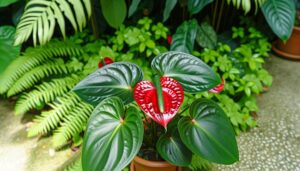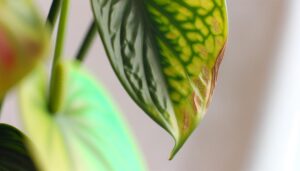Why Is My Anthurium Flower Turning Brown? Causes & Solutions
Your Anthurium flowers are browning due to several potential causes. Overwatering often leads to root rot and flower deterioration, while insufficient watering results in dehydration.
Poor drainage further exacerbates water issues. Low humidity, below essential levels (60-80%), damages flowers, and excessive light exposure causes cellular damage.
Temperature extremes, either below 60°F or above 90°F, result in metabolic disruptions. Nutrient deficiencies, particularly in nitrogen, phosphorus, and potassium, compromise plant health.
Pest infestations and fungal diseases like Anthracnose contribute to browning. Even chemical sensitivity from household products can cause damage.
Addressing these issues helps in reviving your Anthurium’s cruciality. Explore more about specific solutions and preventative measures.
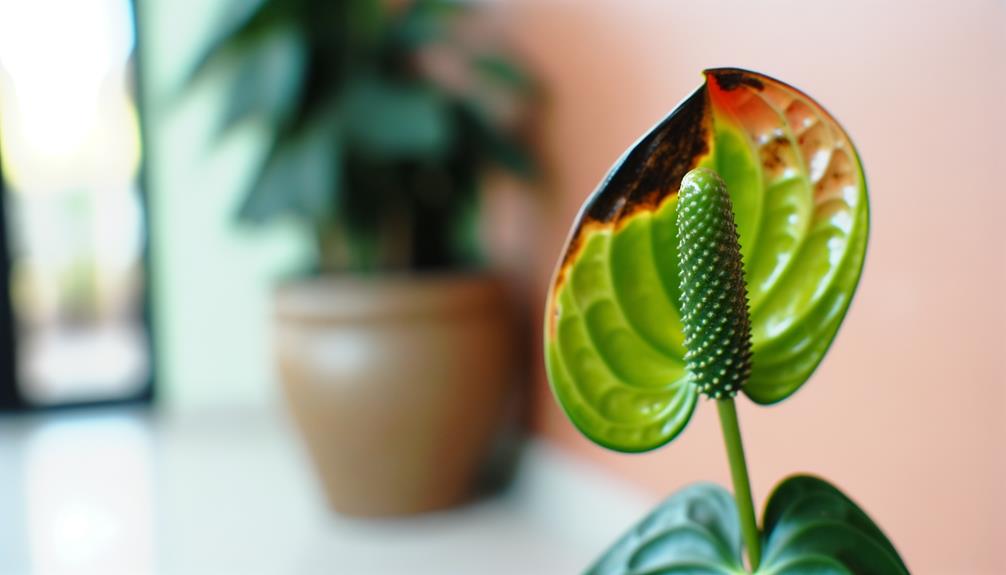
Key Takeaways
- Insufficient watering leads to dehydration, causing flower browning and wilting.
- Overwatering results in root rot and flower deterioration.
- Excessive light exposure or direct sunlight damages cells, turning flowers brown.
- Nutrient deficiencies, particularly in nitrogen, phosphorus, or potassium, can cause browning.
- Pest infestations and fungal diseases like Anthracnose result in browning and lesions.
Insufficient Watering

Insufficient watering can lead to dehydration in Anthurium plants, causing their flowers to turn brown and wilt. You need to understand the significance of watering frequency and maintaining best soil moisture.
Without enough water, the plant’s cells can’t maintain turgor pressure, leading to wilting and browning of flowers. Regularly check the soil moisture by inserting your finger about an inch deep; it should feel slightly damp but not soggy.
Dehydration also causes leaf discoloration, with older leaves turning yellow or brown at the edges. These signs indicate compromised plant health.
Ensuring consistent watering helps maintain vibrant flowers and healthy leaves, essential for the overall well-being of your Anthurium.
Overwatering Issues
Overwatering can lead to root rot in Anthurium plants, causing their flowers to turn brown and deteriorate. Excessive moisture in the soil deprives roots of oxygen, fostering fungal growth. To avoid this, make sure you’re not watering too frequently.
Observe the following key points:
- Watering Frequency: Allow the top inch of soil to dry out before watering again.
- Fertilizer Application: Overwatered plants can’t absorb nutrients effectively. Opt for a balanced fertilizer, and apply sparingly.
- Sunlight Exposure: Place your Anthurium in bright, indirect light to aid in moisture evaporation.
- Soil Type: Use well-draining soil tailored for tropical plants.
Poor Drainage
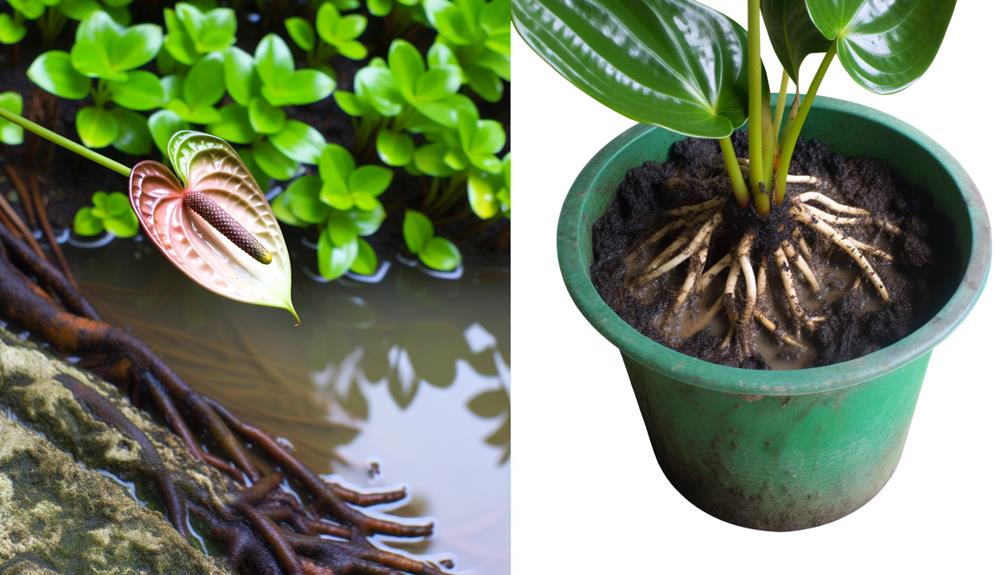
You might notice your Anthurium’s flowers turning brown due to poor drainage, which leads to waterlogged root issues.
Inadequate soil drainage worsens this problem, as the roots can’t access sufficient oxygen.
Additionally, selecting the appropriate pot with drainage holes is essential to prevent excess water accumulation.
Waterlogged Root Issues
Poor drainage can lead to waterlogged roots, which deprive Anthurium plants of essential oxygen and result in browning leaves. To maintain root health and effective root rot prevention, you need to sustain proper aeration and regulate watering frequency.
Consider these key steps:
- Check drainage holes: Confirm pots have sufficient holes to encourage proper aeration.
- Watering schedule: Adjust watering frequency to prevent soil from becoming overly saturated.
- Potting mix: Use a well-draining mixture to facilitate oxygen flow and root health.
- Inspect roots: Regularly check for signs of root rot, such as mushy or discolored roots.
Soil Drainage Problems
Proper soil drainage is critical for Anthurium plants, as it prevents water accumulation that can suffocate roots and lead to browning leaves.
When soil compaction occurs, water and air struggle to penetrate the root zone, causing root rot and yellowing leaves. Compacted soil restricts oxygen flow, leading to anaerobic conditions that promote pathogenic fungi.
This environment not only damages roots but also interferes with nutrient uptake, resulting in nutrient deficiencies. Evidence suggests that well-draining soil mixtures, such as those containing perlite or orchid bark, can mitigate these issues.
Regularly monitoring soil moisture and ensuring proper aeration can prevent the adverse effects associated with poor drainage, safeguarding your Anthurium from discoloration and health decline.
Pot Selection Matters
Selecting an appropriate pot with adequate drainage holes is vital to prevent waterlogging and subsequent browning of Anthurium leaves. The pot size and material have a significant impact on water retention and root health.
Guarantee the pot has multiple drainage holes strategically placed at the bottom to allow excess water to escape. This reduces the risk of root rot and promotes aeration.
Consider the following factors:
- Pot Size: Too small can restrict root growth; too large can retain excess moisture.
- Material: Terra cotta pots are breathable, while plastic retains more moisture.
- Drainage Holes: Guarantee they’re numerous and well-placed.
- Elevated Placement: Use a pot with feet or place it on a stand to improve drainage.
Proper pot selection is essential for maintaining healthy Anthurium flowers.
Inadequate Humidity
You must maintain ideal humidity levels, as Anthurium flowers thrive in environments with 60-80% humidity. Regular misting and the use of humidifiers can effectively mitigate the risk of brown tips caused by dry air.
Empirical studies have shown that consistent moisture in the air prevents cellular dehydration, ensuring healthy, vibrant blooms.
Optimal Humidity Levels
Anthurium plants thrive in environments with humidity levels between 70% and 80%, and inadequate humidity can lead to browning of the leaves.
Proper humidity control is essential in plant care, especially in indoor gardening, where natural moisture levels might be insufficient.
When the air is too dry, the plant’s transpiration process accelerates, causing dehydration and stress.
To maintain ideal humidity levels, consider:
- Grouping plants together: This can create a microenvironment with higher moisture.
- Using a humidity tray: Placing a tray filled with water and pebbles under the plant.
- Positioning near water sources: Like aquariums or kitchens.
- Monitoring with a hygrometer: Ensures you can adjust conditions as needed.
Understanding these factors helps in maintaining a flourishing Anthurium.
Misting and Humidifiers
To combat inadequate moisture effectively, utilizing misting techniques and humidifiers can greatly improve the moisture levels around your Anthurium.
Misting benefits include direct hydration to the plant’s foliage, which can reduce the occurrence of browning flowers.
Aim to mist your Anthurium in the morning to allow water to evaporate during the day, preventing mold growth.
Humidifiers, on the other hand, provide a consistent moisture level. For best results, maintain your humidifier regularly by cleaning it and replacing filters as recommended by the manufacturer.
This prevents the accumulation of bacteria and mold, ensuring a clean and consistent moisture output.
Proper humidifier maintenance is optimal to avoid introducing pathogens that could harm your Anthurium, thereby keeping it healthy and vibrant.
Preventing Dry Air
Maintaining adequate moisture levels is vital for preventing the drying and browning of Anthurium flowers. You need to make sure that humidity levels around your plant are consistently high.
Here’s how to create an ideal environment:
- Use a humidity tray: Place your Anthurium on a tray filled with water and pebbles to increase ambient moisture.
- Group plants together: This method enhances localized humidity through collective transpiration.
- Monitor air circulation: Ensure good airflow without direct drafts, which can lower humidity.
- Employ a hygrometer: Regularly check humidity levels to maintain a perfect range of 70-80%.
These steps help in mitigating inadequate moisture, optimizing your Anthurium’s growth. Enhanced air circulation and stable humidity levels are essential in preventing the flower’s browning.
Improper Light Exposure

While inadequate light can hinder photosynthesis, excessive light exposure often leads to the browning of Anthurium flowers due to cellular damage and stress.
High light intensity can cause temperature variations that worsen this damage, resulting in scorched leaves and flowers. When you expose your Anthurium to direct sunlight, its delicate tissues suffer from photoinhibition, and the plant can’t effectively utilize the light for growth.
Optimal light exposure should be bright but indirect. Additionally, ensure proper air circulation around the plant to alleviate temperature spikes and reduce stress.
Placing your Anthurium in an east-facing window with filtered light can provide ideal conditions, preventing the harmful effects of both inadequate and excessive light exposure.
Nutrient Deficiencies
Nutrient insufficiencies often appear in Anthurium flowers as browning, especially when necessary elements like nitrogen, phosphorus, and potassium are lacking. These nutrients are essential for maintaining prime pH balance and overall plant health.
When Anthuriums don’t receive adequate nutrients, they show symptoms such as:
- Yellowing leaves: Indicative of nitrogen insufficiency.
- Stunted growth: Often due to a lack of phosphorus.
- Weak stems: A sign of potassium insufficiency.
- Micronutrient insufficiencies: Such as iron or magnesium, also cause browning.
Monitoring the soil’s pH balance guarantees nutrients are accessible to the plant, thereby averting insufficiencies. Regularly using a balanced fertilizer can alleviate these issues.
Conduct soil tests to identify specific nutrient shortages and adjust your care regimen accordingly.
Pest Infestations
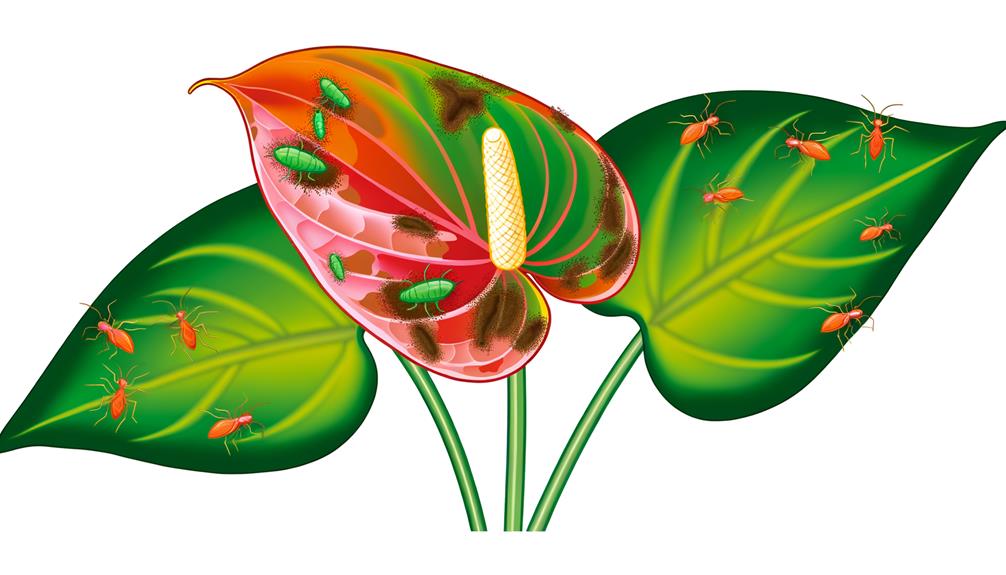
Pest infestations often lead to Anthurium flowers turning brown, with common culprits including aphids, spider mites, and mealybugs.
These pests feed on the plant’s sap, causing stress and discoloration. You might notice tiny webs or sticky residue, which are telltale signs.
Employing natural predators like ladybugs and predatory mites can help manage these pests. Additionally, integrated pest management (IPM) offers a holistic approach, combining biological controls, cultural practices, and mechanical methods to reduce pest populations effectively.
Regularly inspecting your Anthurium and maintaining ideal conditions can prevent infestations. Evidence shows that a well-balanced IPM strategy not only curbs pest issues but also promotes overall plant health, minimizing the risk of brown, damaged flowers.
Fungal Diseases
You need to recognize that common fungal infections such as Anthracnose and Phytophthora can cause Anthurium flowers to turn brown. Look for symptoms like dark lesions, wilting, and mold growth to identify these issues early.
Effective treatment and prevention include fungicidal applications and ensuring proper ventilation and drainage.
Common Fungal Infections
Identifying common fungal infections in Anthurium flowers, such as Anthracnose and root rot, is crucial for effective disease management and plant health.
These infections can severely impact your plant’s vitality and aesthetic appeal. Implementing fungal prevention and proper care strategies is essential for maintaining Anthurium health and ensuring vibrant growth.
Key fungal infections include:
- Anthracnose: Caused by the Colletotrichum fungus, leading to browning and lesions.
- Root Rot: Often due to overwatering, causing root decay and poor nutrient absorption.
- Leaf Blight: Results from fungal pathogens, creating dark spots and tissue necrosis.
- Powdery Mildew: Appears as white powdery spots, inhibiting photosynthesis.
Symptoms to Identify
When dealing with fungal diseases in Anthurium flowers, you’ll notice specific symptoms such as browning, lesions, and necrotic tissue that indicate the presence of pathogens like Anthracnose or root rot.
Brown leaf tips often emerge due to inadequate sunlight, but when combined with fungal lesions, it signals a more severe issue.
Yellowing leaves, which can suggest nutrient deficiency, may also accompany fungal infections, complicating diagnosis.
Look for dark, water-soaked spots that expand into large necrotic areas; these are classic signs of fungal invasion.
Additionally, root rot manifests as mushy, discolored roots, hampering nutrient uptake and further exacerbating leaf yellowing.
Identifying these symptoms early allows for timely intervention and helps mitigate further damage to your Anthurium.
Treatment and Prevention
Effective treatment and prevention of fungal diseases in Anthurium flowers hinge on timely interventions such as proper sanitation, appropriate fungicide applications, and enhanced growing conditions.
Start by removing infected leaves and flowers using precise pruning techniques to prevent the spread of pathogens. Sterilize your pruning tools to maintain proper flower care.
Address the plant’s fertilizing needs to boost its immune system, as deficiencies can lead to leaf yellowing and increased susceptibility to fungi.
- Ensure sufficient air circulation: Prevents moisture buildup.
- Use a fungicide spray: Apply as per instructions for effective control.
- Maintain soil drainage: Avoid waterlogged conditions.
- Monitor humidity levels: Keep within ideal ranges for Anthuriums.
Temperature Extremes
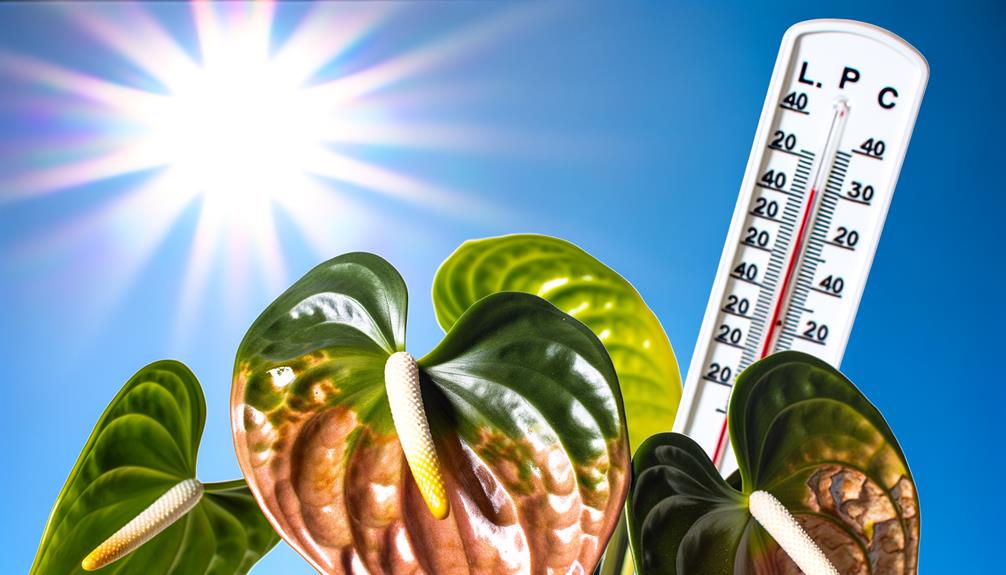
Temperature extremes can cause significant stress to Anthurium plants, leading to browning of the flowers due to cellular damage and disrupted metabolic processes.
When exposed to temperatures below 60°F or above 90°F, Anthuriums experience physiological distress, impairing nutrient and water uptake.
To mitigate this, consider implementing climate control measures such as maintaining a consistent indoor temperature using a thermostat. Additionally, insulation tips like placing your plant away from drafty windows or doors can prevent cold stress.
Conversely, avoid placing Anthuriums near heat sources like radiators or direct sunlight, which can lead to overheating.
Chemical Sensitivity
Besides temperature extremes, Anthurium flowers are highly sensitive to chemicals, particularly those found in household cleaning products, pesticides, and certain fertilizers, which can cause browning and other damage.
Exposure to these substances disrupts the plant’s air purification abilities and exacerbates its vulnerability to indoor pollutants.
To prevent chemical sensitivity issues, consider the following:
- Use non-toxic, organic fertilizers: These are less likely to cause chemical burns or browning.
- Avoid using harsh pesticides: Opt for natural pest control methods to minimize risk.
- Minimize exposure to household cleaning products: Make sure that cleaning sprays and detergents aren’t used near your Anthurium.
- Regularly ventilate the room: This helps disperse any lingering indoor pollutants, maintaining a healthier environment for your plant.
Conclusion
You’ve learned that anthurium flowers turning brown can stem from either too little water or too much. While poor drainage and low humidity don’t help, excessive light or pest infestations also play their part. Fungal diseases and temperature swings add to the complexity, just as chemical sensitivity can be the final culprit. Balancing these factors guarantees vibrant blooms.
It’s a delicate dance, but with careful attention, you can restore your anthurium’s beauty and health.



